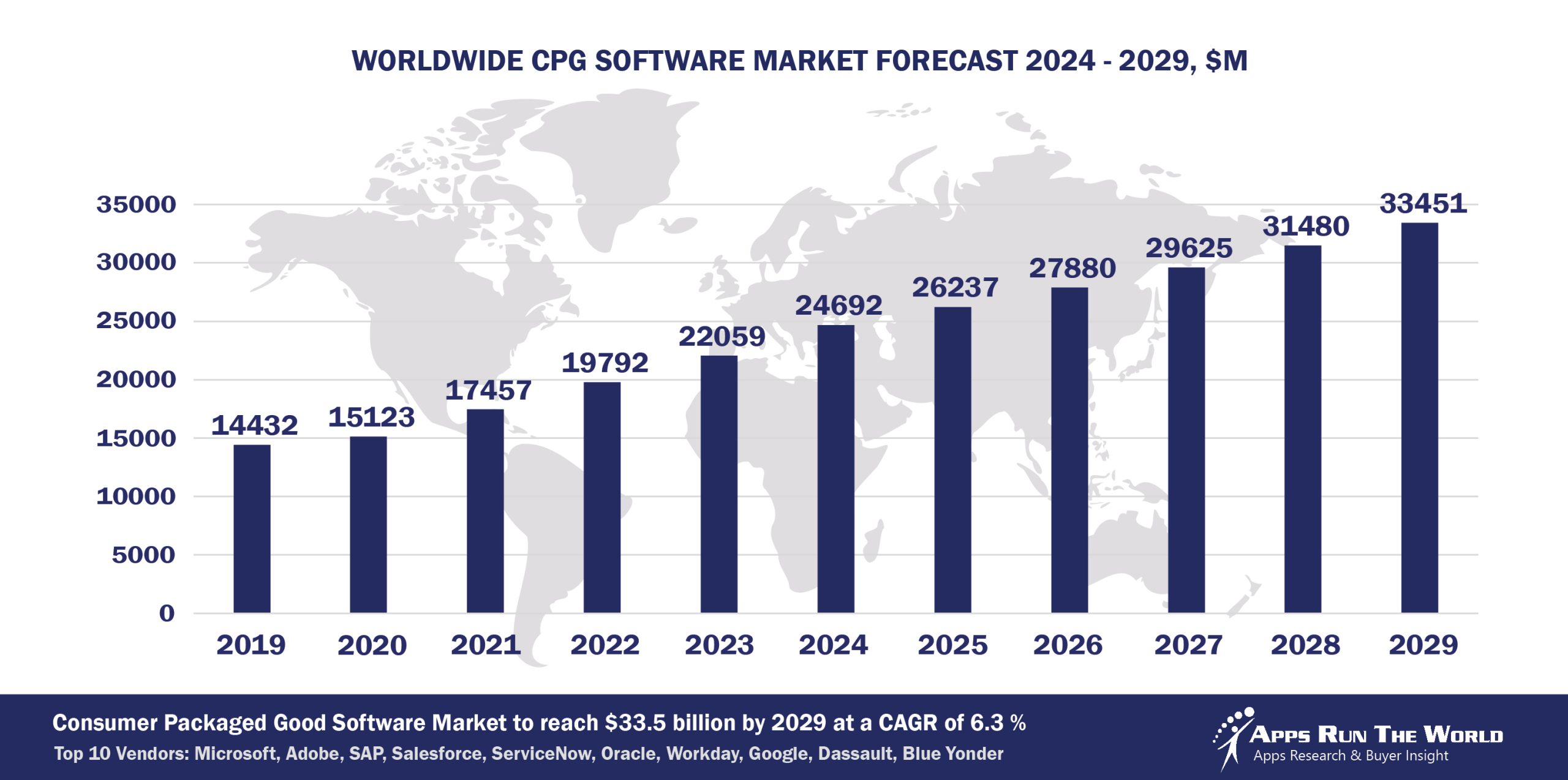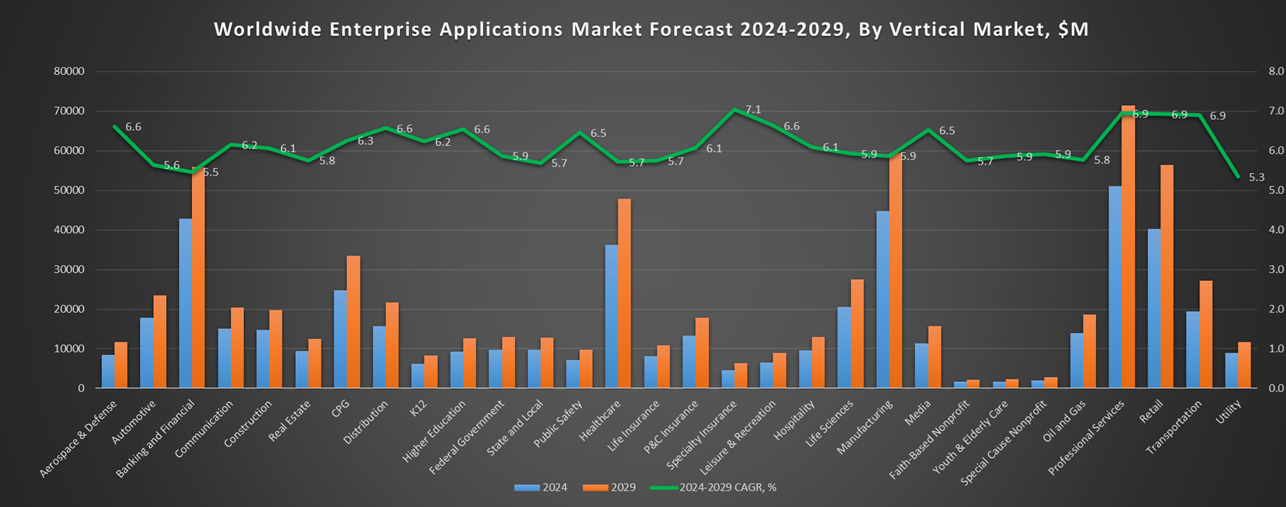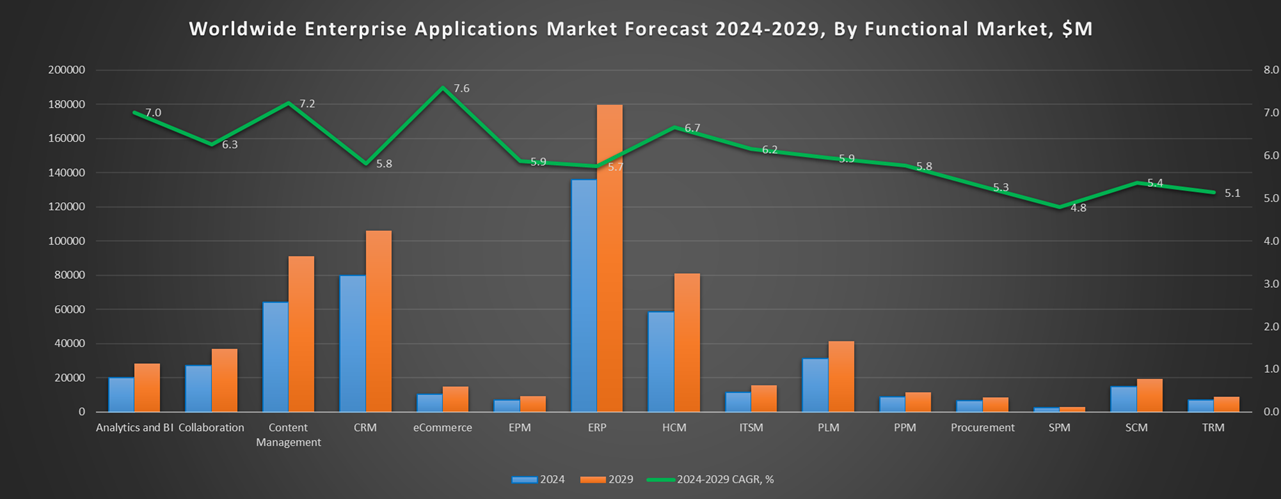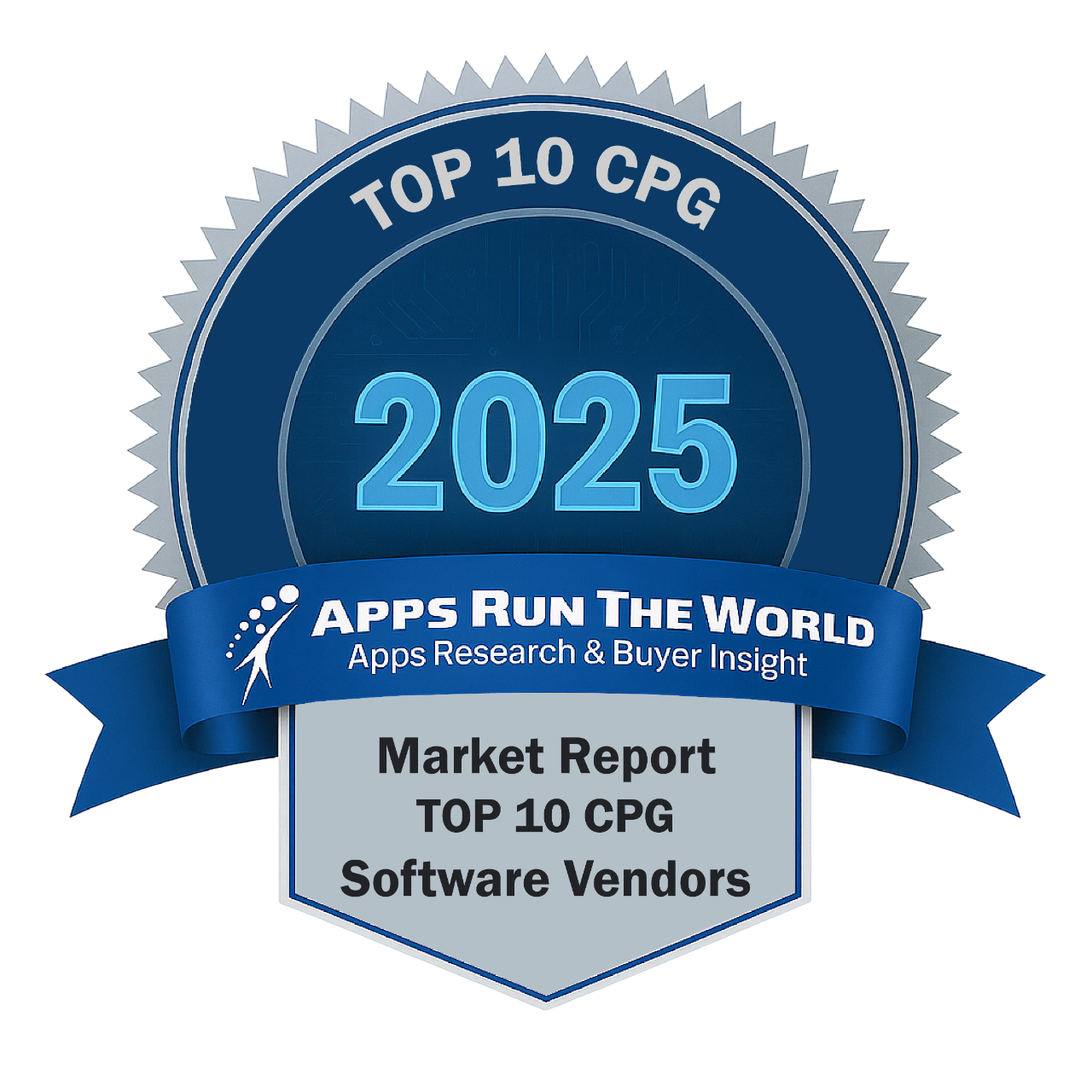
In 2024, the global Consumer Packaged Goods software market grew to $24.7 billion, marking a 11.9% year-over-year increase. The top 10 vendors accounted for 50.8% of the total market. Microsoft led the pack with a 10.8% market share, followed by Adobe, SAP, and Salesforce.
Through our forecast period, the Consumer Packaged Goods applications market size is expected to reach $33.5 billion by 2029, compared with $24.7 billion in 2024 at a CAGR of 6.3%, as shown in the Apps Top 500 Report – Excel Edition [Preview] .
Consumer & Packaged Goods (Consumer goods including non-durables, apparel, food and beverage and packaged goods) – Product lifecycle management, Supply Chain Management. eCommerce, Pricing Optimization, Financials, HR, Procurement
PLM systems are gaining traction among CPG firms; the same applies to compliance and risk management. Better use of agriculture technology systems, as well as the Internet of Things, could transform the food industry.
Top 10 Consumer Packaged Goods Software Vendors in 2024 and their Market Shares
Source: Apps Run The World, July 2025
Other Consumer Packaged Goods software providers included in the report are ADP, Ansys Inc., Atlassian, Autodesk, Box Inc., Cisco Systems, Citrix, Cadence Design Systems, Constellation Software Inc., Dassault Systemes, DocuSign, Inc., Dropbox, Famous Software, Genesys Telecommunications Laboratories, Global Payments Inc., Google, HubSpot, Intuit Inc., Infor, IBM, Kibo, Nice Systems, Open Text Corporation, Paycom, Pegasystems, PTC, Property Works, PROS Holdings, Qlik, Sage, Shopify, Siemens Digital Industries Software, SolarWinds, StayinFront, Symphony RetailAI, Teradata Corporation, Trace One, Tugboat Software, UKG, Verint Systems Inc., Visma, Yonyou, Workiva, Zendesk, Zoho Corp. and many others.
Vendor Snapshot: Consumer Packaged Goods Market Leaders
 Microsoft
Microsoft
Microsoft’s strategic evolution in the CPG sector centers on democratizing intelligent automation through tightly integrated agentic capabilities across its cloud, productivity, and ERP ecosystems. It’s leveraging AI copilots and orchestration agents to drive end-to-end supply visibility, autonomous financial reconciliation, and proactive marketing execution, especially via its low-code frameworks. In CPG-specific deployments, Microsoft is enabling business users to build contextual agents that operate across finance, operations, and collaborative workflows, surfacing predictive insights and initiating corrective actions autonomously.
Adobe
Adobe is transforming CPG engagement by embedding generative and agentic AI into its real-time experience engine, enabling autonomous personalization across DTC, retail media, and omnichannel touchpoints. Through modular data services and low-code orchestration, CPG brands can now deploy self-optimizing agents that iterate creative content, segment audiences dynamically, and refine campaign orchestration based on contextual inputs. Adobe’s recent advances enable marketers to configure AI agents that continuously adapt consumer journeys across product launches or seasonal shifts. With increasing focus on real-time experimentation and reinforcement learning loops, Adobe is positioning its stack as the core intelligent engagement layer for data rich CPG environments.
SAP
SAP’s roadmap is increasingly anchored on agentic intelligence to automate planning, logistics, and commercial execution in CPG enterprises. Building on its Business Technology Platform and embedded AI accelerators, SAP is enabling autonomous supply agents that self-adjust procurement, manage vendor risks, and rebalance inventory in response to demand signals. Its recent platform enhancements support embedded LLMs and contextual AI copilots that act across planning, sourcing, and financial scenarios with limited human intervention.
Salesforce
Salesforce is redefining CPG execution with autonomous agents that operate across retail execution, commerce, and consumer intelligence layers. Its generative AI copilots are evolving into agentic orchestrators that help field reps, brand managers, and eCommerce teams coordinate pricing, merchandising, and loyalty offers in near real time. The platform’s Data Cloud underpins continuous learning workflows where AI agents ingest demand signals, social sentiment, and POS data to autonomously tune marketing and sales strategies. Salesforce’s low-code Flow and Einstein 1 integration enable CPG firms to compose and govern intelligent workflows without deep technical expertise, signaling a strategic shift toward agent-led operational agility at scale.
ServiceNow
ServiceNow’s AI-first CPG vision is grounded in building proactive, autonomous workflows across service, quality, and supplier collaboration domains. Its embedded generative agents can now autonomously triage and resolve compliance issues, quality deviations, or field service failures, minimizing human bottlenecks in high-velocity production and distribution environments. With Now Assist and Creator Workflows, CPG firms are deploying conversational interfaces that unify disparate systems, triggering workflows or agents that execute corrective actions in real time.
Oracle
Oracle is operationalizing agentic AI across its integrated CPG suite, enabling autonomous agents that optimize planning, procurement, financials, and workforce alignment through a shared AI governance framework. Its generative capabilities, embedded directly into transaction flows and analytics, allow business users to configure agents that interpret trends, simulate forecasts, and trigger dynamic reallocation of resources with minimal oversight. Oracle’s roadmap is focused on building multi-domain agent ecosystems, where AI actors collaborate across supply, HR, and finance to deliver adaptive enterprise performance.
Workday
Workday’s strategy in the CPG sector focuses on embedding agentic intelligence into financial, workforce, and planning processes to create closed-loop decision cycles. Its recent enhancements allow enterprise users to deploy generative agents that autonomously reconcile costs, adjust headcount plans, or simulate scenarios around SKU profitability, without technical coding. By integrating LLMs into its analytics stack and planning workflows, Workday empowers CPG finance teams to build intelligent, low-code agents that connect market dynamics to workforce and spend outcomes.
Google is enabling CPG brands to operationalize end-to-end autonomous analytics by converging its Vertex AI, Looker, and BigQuery assets into a modular AI fabric. Its tools allow CPG teams to develop agentic workflows that monitor product sentiment, detect retail anomalies, and simulate pricing elasticity using real-time signals. With Duet AI embedded in Looker and Workspace, Google empowers cross-functional teams to build and query AI agents conversationally, shortening insight-to-action cycles. Its commitment to low-code AI agent creation, model retraining, and governed data activation gives CPG leaders the infrastructure to deploy scalable, self-learning systems aligned to consumer, channel, and promotional strategies.
Dassault Systemes
Dassault is enabling CPG manufacturers to deploy autonomous agents across R&D, formulation, and production using its model-based digital twin architecture. Through closed-loop integration between design, quality, and MES systems, CPG firms are leveraging AI agents to validate packaging compliance, optimize batch scheduling, and simulate sustainability impacts in real time. The platform’s agentic capabilities are designed for complex scenario management, such as dynamically shifting production across global facilities based on raw material volatility or market demand. Dassault’s composable agent framework and no-code simulation environments are empowering innovation teams to embed intelligence into every stage of the product lifecycle.
Blue Yonder
Blue Yonder is at the forefront of agentic AI in the supply chain, enabling CPG companies to orchestrate autonomous decision-making across inventory, demand, fulfillment, and last-mile delivery. Its Luminate platform now supports embedded generative agents that simulate disruptions, optimize trade-offs, and execute adjustments without human initiation. By integrating reinforcement learning and causal inference, Blue Yonder agents can continuously learn from signal feedback and improve operational accuracy. Its focus on control tower autonomy and conversational command interfaces allows planners to supervise and reprogram supply chain agents on the fly, unlocking true hands-free supply execution in CPG ecosystems.
ARTW Technographics Platform: Consumer Packaged Goods customer wins
Since 2010, our research team has been studying the patterns of the Consumer Packaged Goods software purchases, analyzing customer behavior and vendor performance through continuous win/loss analysis. Updated quarterly, the ARTW Technographics Platform provides deep insights into thousands of Consumer Packaged Goods customer wins and losses, helping users monitor competitive shifts, evaluate vendor momentum, and make informed go-to-market decisions.
List of Consumer Packaged Goods customers
Source: ARTW Buyer Insights Technographic Database
Custom data cuts related to the Consumer Packaged Goods Applications market are available:
- Top 1000+ Consumer Packaged Goods Applications Vendors and Market Forecast 2024-2029
- 2024 Consumer Packaged Goods Applications Market By Functional Market (16 Markets)
- 2024 Consumer Packaged Goods Applications Market By Country (USA + 45 countries)
- 2024 Consumer Packaged Goods Applications Market By Region (Americas, EMEA, APAC)
- 2024 Consumer Packaged Goods Applications Market By Revenue Type (License, Services, Hardware, Support and Maintenance, Cloud)
- 2024 Consumer Packaged Goods Applications Market By Customer Size (revenue, employee count, asset)
- 2024 Consumer Packaged Goods Applications Market By Channel (Direct vs Indirect)
- 2024 Consumer Packaged Goods Applications Market By Product
Worldwide Enterprise Applications by Vertical Market
Exhibit 3 provides a forecast of the worldwide enterprise applications by vertical market from 2024 to 2029, highlighting market sizes, year-over-year growth, and compound annual growth rates across different industry sectors from Aerospace and Defense to Utilities.
Exhibit 3: Worldwide Enterprise Applications by Vertical Market Forecast 2024-2029 by Functional Market ($M)
Source: Apps Run The World, July 2025
Exhibit 4 shows our projections for the enterprise applications market by vertical segment, based on the buying preferences and the customer propensity to invest in new software within those industries as they continue to upgrade and replace many legacy industry-specific applications that have been identified and tracked in our Buyer Insight Database.


FAQ – APPS RUN THE WORLD Top 10 Consumer Packaged Goods Software Vendors, Market Size & Forecast
Q1. What is the global Consumer Packaged Goods (CPG) software market size in 2024?
A: The global CPG software market was $24.7 billion in 2024, growing 11.9% year‑over‑year.
Q2. Who are the top 10 CPG software vendors in 2024, and what share do they hold?
A: The top 10 vendors are Microsoft, Adobe, SAP, Salesforce, ServiceNow, Oracle, Workday, Google, Dassault Systèmes, and Blue Yonder, collectively accounting for 50.8% of the CPG software market.
Q3. Which vendor leads the CPG software market in 2024?
A: Microsoft leads with about 10.8% market share in 2024.
Q4. What is the forecast for the CPG software market through 2029?
A: The market is expected to reach $33.5 billion by 2029, growing from $24.7 billion in 2024 at a 6.3% compound annual growth rate (CAGR).
Q5. What kinds of functions are included in the scope of the CPG software market?
A: It includes product lifecycle management, supply chain management, eCommerce, pricing optimization, financials, HR, and procurement.
Q6. Which other CPG software vendors are covered beyond the top 10?
A: The report also profiles vendors such as Infor, IBM, and niche specialty providers offering solutions in areas like retail media, packaging, and sustainability.
Q7. When was this CPG software report published and by whom?
A: The report was published in July 2025 by APPS RUN THE WORLD analysts Albert Pang, Misho Markovski, and Marija Ristik, as part of the APPS TOP 500 research program, which benchmarks the revenues and market share of the world’s 1,500+ largest enterprise application vendors.
More Enterprise Applications Research Findings
Based on the latest annual survey of 10,000+ enterprise software vendors, Apps Run The World is releasing a number of dedicated reports, which profile the world’s 1,500 largest Enterprise Applications Vendors ranked by their 2024 product revenues. Their 2024 results are being broken down, sorted and ranked across 16 functional areas (from Analytics and BI to Treasury and Risk Management) and by 21 vertical industries (from Aerospace to Utility), as shown in our Taxonomy. Further breakdowns by subvertical, country, company size, etc. are available as custom data cuts per special request.
Research Methodology
Each year our global team of researchers conduct an annual survey of thousands of enterprise software vendors by contacting them directly on their latest quarterly and annual revenues by country, functional area, and vertical market.
We supplement their written responses with our own primary research to determine quarterly and yearly growth rates, In addition to customer wins to ascertain whether these are net new purchases or expansions of existing implementations.
Another dimension of our proactive research process is through continuous improvement of our customer database, which stores more than one million records on the enterprise software landscape of over 2 million organizations around the world.
The database provides customer insight and contextual information on what types of enterprise software systems and other relevant technologies are they running and their propensity to invest further with their current or new suppliers as part of their overall IT transformation projects to stay competitive, fend off threats from disruptive forces, or comply with internal mandates to improve overall enterprise efficiency.
The result is a combination of supply-side data and demand-generation customer insight that allows our clients to better position themselves in anticipation of the next wave that will reshape the enterprise software marketplace for years to come.
- Platned, a United Kingdom based Professional Services organization with 150 Employees
- Datadog, a United States based Professional Services company with 5200 Employees
- Comviva Technologies, a India based Professional Services organization with 3000 Employees
| Logo | Company | Industry | Employees | Revenue | Country | Evaluated |
|---|


 Microsoft
Microsoft